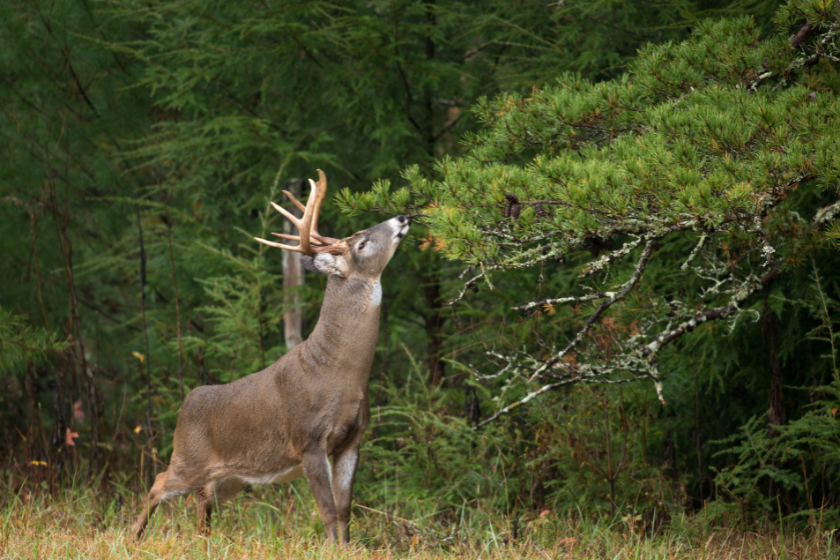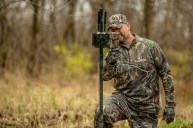During the summer months, there is usually only one thing on every whitetail hunter's mind: velvet bucks! More specifically, it's using trail cameras to pattern our target bucks in preparation for the upcoming season that really gets us excited. Traditional methods for catching those big bucks on camera include mineral sites, corn feeders, food plots, etc. However, some states don't allow supplemental feeding for deer, and depending on what type of property you're hunting, a food plot might not be an option. If this is the case for you (or maybe you're already doing all of those things and still can't get your target buck to appear consistently on camera), there is still hope. Mock scrapes are an incredible way to entice a mature buck to your area, and when done right, you may even get him on camera.
When most people hear the term "scrape," their minds immediately go to late October and early November when scrapes appear in large numbers as bucks are marking their territory and checking does for estrus. However, if the rut is the only time you're utilizing mock scrapes, you're missing a much larger piece of the puzzle.
Basically speaking, a deer scrape is a spot where bucks rub their forehead, preorbital and nasal glands on a low-hanging tree branch, then scrape the ground below free of leaves or debris for them to urinate on. It's all about scent-spreading.
A few years ago, I started focusing on mock scrapes for the entire summer. I did this because I wanted to build an inventory of which bucks made it through the winter, and to develop a way to pattern summer deer activities. I was amazed by the number of trail cam pictures I was getting over my scrapes, and what was even more incredible was how many bucks showed up that I hadn't seen before.
It seems so simple now, but it's something I overlooked for so many years. Whitetail deer are constantly using their senses to communicate with other local deer. So it only makes sense that you could capitalize on this by creating mock communication hubs for whitetail visits.
Deer Hunting Prep With Mock Scrapes

EEI_Tony via Getty Images
Find the Right Location
Unlike during the pre-rut, you may have to be more selective about where you make your mock scrapes during the preseason. Bucks are not nearly as aggressive this time of year, so quality over quantity is critical during the summer months. But with some scouting, you should be able to find a perfect spot to set up and hang a camera.
Picking the right location during the preseason might take more patience and scouting, but I look for a few things when deciding where to put them. I like to look for trails between thick bedding areas and a primary food source. This will be an area that deer will be traveling through regularly and a spot they would use consistently to communicate with other does and bucks in the area.
Another great place to set up mock scrapes is along old logging roads. Even during the preseason, I will find multiple territorial scrapes along the logging road that runs between two oak patches on one of my farms. The flattened ground, low resistance, and overhanging limbs on the edges make it an ideal spot for a buck to make a scrape.
Create the Scrape
Once you find an excellent location to set up your mock scrape, you must spend time finding a good low-hanging limb. The licking branch is arguably the most vital part of a good scrape. This could be the difference between a scape that consistently attracts mature bucks and one that goes cold.
I like to choose branches from trees that I know are desirable to deer. This could vary depending on what part of the country you're hunting. Here in the Midwest, oak tree limbs are a favorite for deer. Cedar and young beech trees are also great ones to look for when setting up your scrape.
Another standard method is to create your own tree and licking branch, which I do every year, especially during the rut. I like to put a cedar post into the ground, as the deer already love the scent it gives off. I typically will bury an eight-foot post into the soil about three feet and use a flag holder to mount a small oak branch about neck high.
After this, I like to take the heel of my boot and scrape away the leaves and grass until there is an oval of bare dirt with about a two-foot radius. At this point, many hunters will pour buck urine, synthetic or natural, into the ground. You'll even hear stories about hunters using their own "buck man juice" to put the finishing touches on a scrape.
I have found that exposing the bare ground will be enough to entice a buck to visit, so I typically avoid pouring any urine on the ground. However, I have found that using a pre-orbital or forehead gland scent for the licking branch helps the bucks find it quicker, which is always a plus.
Hang the Camera

Pierdelune via Getty Images
The last task is to hang a trail camera and monitor the results. I like to use a cellular camera on all of my mock scrapes because the less human scent in the area, the better. Make sure to use lithium batteries, as cell cameras tend to burn through batteries quickly. Although you won't get nearly as many pictures as you would at a corn feeder, I will create a few mock scrapes in the preseason and not even visit them unless I am hunting nearby once the season starts.
If you're in a state that doesn't allow mineral sites or any form of supplemental feeding, or maybe you're having a hard time getting that camera-shy trophy buck to show up, making a mock scrape might be the perfect way to entice him and get him on a regular pattern. Find a good location, pick a good tree, limit your intrusion, and I promise you'll be surprised by how much action you see.




